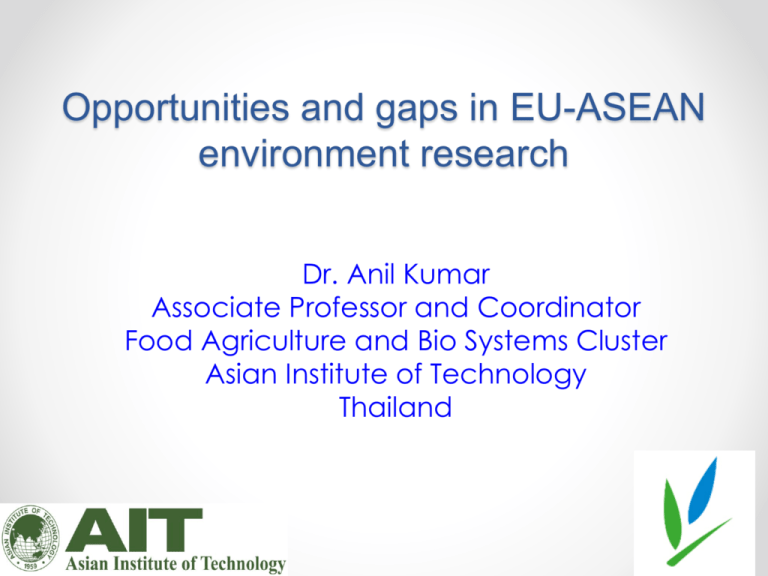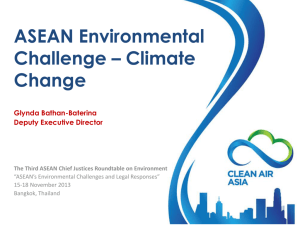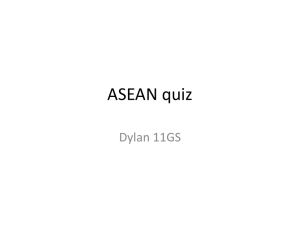Presentation - ASEAN
advertisement

Opportunities and gaps in EU-ASEAN environment research Dr. Anil Kumar Associate Professor and Coordinator Food Agriculture and Bio Systems Cluster Asian Institute of Technology Thailand ASEAN Countries: Differences ASEAN countries may be divided into a few sub-groups including: (i) high-income developed country such as Singapore, (ii) medium-tohigh-income developing countries such as Brunei, Malaysia, Thailand, Indonesia, the Philippines, and Vietnam, and (iii) Low-income developing countries such as Laos, Cambodia, and Myanmar. Per capita GDP in Singapore, which topped the list of ASEAN countries in 2012, was about 40 times greater than that of Myanmar, at the bottom (ADB, 2013). Wide differences in percentage of urban population, ranging from a low percentage of 22% in Cambodia to more than 70% in Malaysia and Brunei, and 100% in Singapore (ADB, 2013). Although the percentage of people living in cities is projected to increase in all countries in the region by 2050, some countries such as Cambodia are expected to be predominantly rural in 2050, with at least 60% of their populations in rural areas (ADB, 2013). • • The ASEAN region can be considered a hotspot of climate and resource issues. It is highly vulnerable to the impacts of climate ASEAN is also increasingly contributing to climate change; its greenhouse gas emissions doubled between 1990 and 2010. Greenhouse gas emissions from ASEAN (source: World Bank) Wide differences in per capita GHG emisssions within the region ranging from the lowest of about 1 ton-eq. per capita in Myanmar and the Philippines to about 35 ton-eq. per capita in Brunei, while per capita GHG emissions of the other ASEAN countries are below 9 ton-eq. per capita (ADB, 2013). Urbanization and Use of Transportation Increase in the population (average growth 0.75%) and rapid economic development in the ASEAN region has lead to a rapid increase in motorisation. Expansion of number of motorised, especially in the region’s middle-income countries (e.g. Indonesia, Malaysia, Philippines and Thailand). For example, in Jakarta, the number of motorised vehicles has grown at roughly 9.5% per annum for the past five years. Total passenger-km (PKM) is estimated to grow at a yearly rate of 3.5%, increasing five-fold from 1.5 trillion PKM in 2005 to 7 trillion PKM in 2050 with the annual increase (as in 2005) in road, rail and air transport activity volumes of 3.5%, 2% and 2% respectively. Number of motor vehicles by mode for 6 Southeast Asian countries (Indonesia, Malaysia, Philippines, Singapore, Thailand and Vietnam) *MC-two: Motorized two-wheeler MC-three: three wheeler LCV: Light Commercial vehicle HCV: High Commercial vehicle PC: Personal Car Source: ADB (2009) The total CO2 emissions from land transport in Southeast Asia reached 193Mt in 2005. According to Clean Air Asia, the business-as-usual scenario would result in emissions of 1.6Tt in 2050 Transport CO2 contribution by country in 2005 (source: ITPS, 2014) Waste Management • Solid waste generation in most of the ASEAN countries is relatively high (due to increasing population and economic growth). • ASEAN’s municipal solid waste is mostly comprised of organic waste, followed by paper and plastic. • Solid waste management (collection, transportation and final disposal) is weak – due to insufficient waste collection equipment and landfills and the common practice of open dumping (also directly into rivers), with a low proportion of waste recycled or composted. • Agricultural waste amounts to ≈15% of all waste generated in ASEAN the potential of which to generate energy is wasted. • Other main reasons for the weak waste management in ASEAN are the lack of institutional frameworks and governmental support, resources – particularly financing, technologies, capacity and skills (Ngoc & Schnitzer, 2009). • in Singapore, where about 44.4% of solid waste is recycled (Ngoc & Schnitzer, 2009). Waste Treatment Methods Mostly Open dumping and landfill, followed by incineration and composting Generally, fresh water availability in the ASEAN region is greater than the global average, but is unequally distributed geographically and seasonally (FAO, 2011). For example, in Thailand, 80% of the annual precipitation falls between May and October. Proportion use of water withdrawals by sectors in South East Asia, 2002 (Source: UN-ESCAP, 2011) Availability of natural water resources per unit area by world, region and subregion, 2008 (Source: UNESCAP, 2011) Forestry ASEAN’s total land area is 40% covered with forest and the region contains the world’s third largest tropical forest. Despite being highly forested, South-east Asia’s deforestation rate is the world’s highest but each year the region loses 1.2% of its forest cover, with Cambodia, Indonesia and the Philippines reporting annual losses of two per cent over the last five years (FAO 2006) THANK YOU







